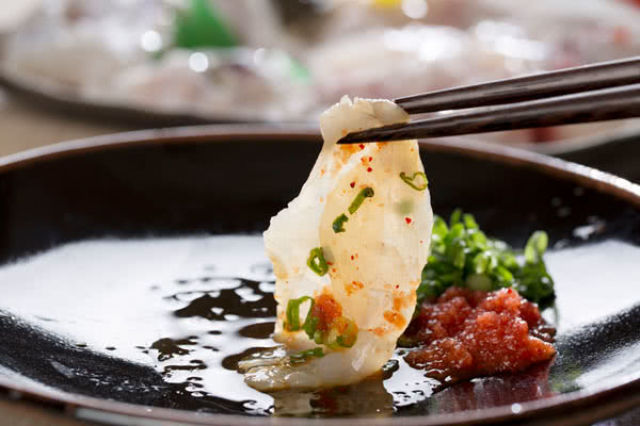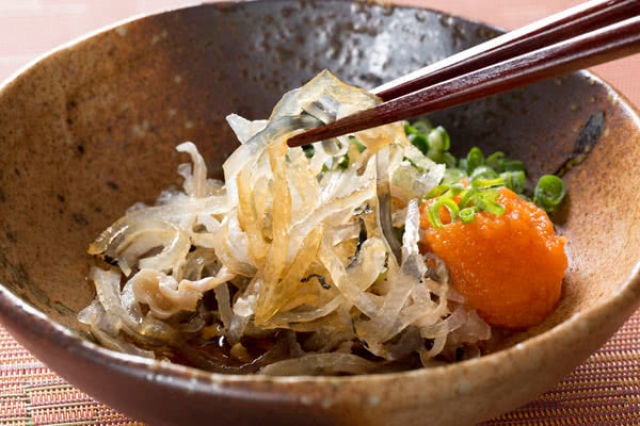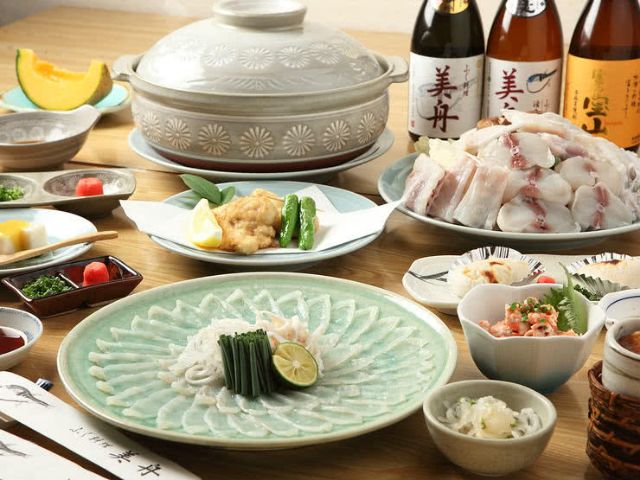Shimonoseki, located in the southwestern region of Japan’s Honshu island, is regarded as the “fugu capital”, although it’s eaten all over the country, albeit by different names. For example, in Kyushu, it is called "fuku", in Nagasaki, it’s "ganba" and in Osaka, it’s "teppo"—teppo means gun in Japanese, a reference to the deadly nature of fugu.
Thrill-seeking is not the only reason that Japanese pufferfish remains so popular - aside from its distinct, subtle flavor and unique chewy texture, fugu is also low in fat and high in protein. Both fugu skin and meat are used in Japanese cuisine, and the meat is very versatile. Fugu was originally a high-class food, but has become more widely available in recent years--although still as a premium-priced fish. Here are 10 excellent fugu dishes that make those prices absolutely worth it.
10 Fantastic Fugu Dishes
Fugu Sashimi
Also known as “fugusashi” or “tessa”, fugu sashimi is one of the most common ways to eat Japanese pufferfish. To prepare the dish, fugu flesh is sliced paper-thin, much thinner than other varieties of fish sashimi, and the slices are elegantly arranged in circle to resemble a chrysanthemum—a little eerie given that the flower symbolizes death in Japanese culture. The plated sashimi is garnished with finishings such as edible flowers, sprouts, daikon and sudachi citrus, and served with ponzu to enhance the flavor of the raw fugu. Fugu sashimi can be ordered in restaurants selling fugu, as well as found in packs at more up-market supermarkets.
Tecchiri
![fugu dishes]() Tecchiri
Tecchiri, or
fugu chirinabe, is a type of nabe—Japanese hot pot—that uses fugu as the feature ingredient. Nabe come in a range of broth flavors and ingredients, and the different regions of Japan have their own signature types of nabe showcasing local specialties. Fugu nabe is a specialty of the Kansai region of Japan, in particular, the Yamaguchi prefecture, as it is close to the Sea of Japan where pufferfish are in abundance. Tecchiri nabe features pieces of rich fugu meat alongside tofu, mushrooms and other vegetables cooked in a dashi broth and served with ponzu. Fugu nabe is a great meal option for fugu first-timers.
Fugu Shirako
![fugu dishes]()
Fugu
shirako is a delicacy for fans, but for newbies it represents one of the more challenging ways to eat fugu. Shirako is the Japanese term for milt, male fish genitalia containing sperm. Other than fugu, the Milt of cod, anko, salmon and squid are also popular ingredients in Japan. Fugu shirako is prized for its exceptional creaminess and gentle oceanic flavor. Common ways to eat fugu shirako is raw and dressed with ponzu and wasabi, cooked in a nabe, or lightly battered and deep-fried, tempura-style.
Fugu Karaage
The most familiar form of Japanese karaage is most likely to tori (chicken) karaage, where pieces of chicken are marinated in sake, soy sauce, salt, garlic and ginger, then coated in a mixture of flour and potato starch and deep-fried until golden brown. However, this preparation technique is also a popular way to cook fish. Fugu karaage is rich in flavor, with a soft, slightly chewy center and crisp outer crust. The deep-fried morsels typically come served with wedge of sudachi lime and salt. Unlike some fugu dishes, this is an easy-to-palate introduction to fugu for beginners.
Sumibiyaki Fugu
![fugu dishes - fugu sumibiyaki]() Sumi
Sumi means charcoal in Japanese, and
sumibiyaki is to grill something over a charcoal fire. Fugu grilled over a charcoal fire is imbued with the smoky flavor of the charcoal, while retaining a juiciness to the meat. It may be cooked as-is, or brushed with a teriyaki sauce of sweetened soy sauce. Fugu cooked in this way has a rich, barbecue-infused flavor.
Fugu no Tataki
![fugu dishes - fugu tataki]() Tataki
Tataki is a Japanese cooking technique where a piece of meat or fish is flash-grilled to sear the outside while keeping the inside raw. It’s then sliced into large chunky slices and served with various condiments. Fugu tataki is most commonly served with
sudachi lime,
myoga (Japanese ginger) and ponzu (citrus-seasoned soy sauce).
Fugu Ojiya
Fugu ojiya is the name of a variety of zosui, or Japanese rice porridge, with fugu as the main attraction. Zosui may be made either by cooking rice with water and sometimes dashi, then adding other ingredients, or by adding rice to a pot of nabe as it nears the end. Making zosui in the final stages of a nabe is a popular way to end a Japanese hot pot meal, and produces an extremely flavorful and nourishing dish—a beloved winter warmer.
Fugu Shabu Shabu
Fugu is used in shabu shabu much like other ingredients—pieces of fugu are swished through a pot of boiling water or dashi until it’s cooked, then dipped into ponzu or sesame sauce. Shabu shabu is another popular type of Japanese hot pot, and is enjoyed in groups with the communal meal cooked tableside. The name, shabu shabu, comes from the sound the ingredients make as they’re swished through the hot broth.
Fugu Skin
Fugu skin may not sound like a stand-alone dish, but in a culture that traditionally values minimizing food waste, it is common to prepare all parts of an animal in a way that brings out their flavor. Fugu skin may be served raw as sashimi, sliced and boiled and served with ponzu, grilled, or deep-fried until it’s crispy—"fugu kawa senbei,” which is said to pair perfectly with a cold beer. In addition to preventing waste and providing new flavor sensations, fugu skin contains high levels of collagen, a protein that improves the skin’s appearance, elasticity and youthfulness, making it particularly popular with women.
Hirezake
For the real culinary daredevils, hirezake is a unique fugu-based tipple. To prepare hirezake (fin sake), a fugu fin is burnt over charcoal and then placed into a cup of kanzake, warmed sake. A lid is the placed over the cup and left to steep for a few minutes, to allow the flavor of the burnt fugu fin to steep into the sake. The result is a beverage with a deeply smoky and savory flavor, coupled with cleanness of sake. It is said that hirezake was developed after the second world war, when there was a lot of poor-quality sake on the market, so fins were added to mask the bad flavor. Now it can be found in select bars and restaurants, usually during winter.
Eating Japanese Pufferfish is Daring and Delectable
Whether you’re after the rush of eating what once was a deadly sea creature, or interested in trying a diverse range of traditional Japanese foods, the wide range of fugu dishes make an appealing meal. For those just starting out, a steaming bowl of fugu nabe with a nip of sake, or a plate of crispy fried fugu karaage washed down with an ice-cold beer are great places to start. For the more daring, fugu shirako and hirezake makes for a boundary-pushing meal, and interesting story to tell friends and family!
Browse Savor Japan’s listings of restaurants where you can try fugu in Japan.
Disclaimer: All information is accurate at time of publication.
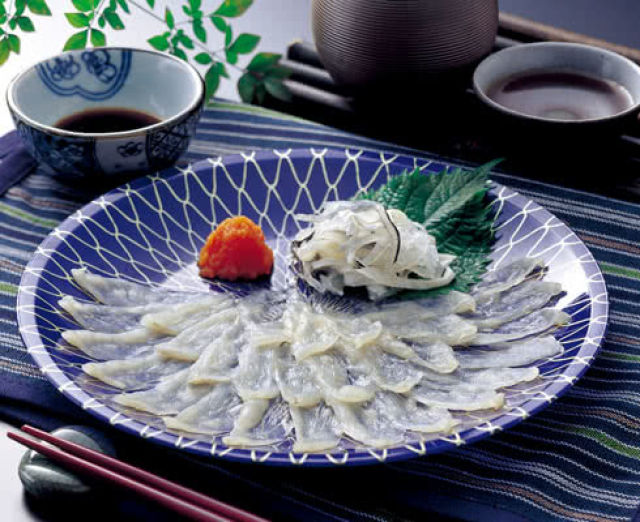
 Tecchiri, or fugu chirinabe, is a type of nabe—Japanese hot pot—that uses fugu as the feature ingredient. Nabe come in a range of broth flavors and ingredients, and the different regions of Japan have their own signature types of nabe showcasing local specialties. Fugu nabe is a specialty of the Kansai region of Japan, in particular, the Yamaguchi prefecture, as it is close to the Sea of Japan where pufferfish are in abundance. Tecchiri nabe features pieces of rich fugu meat alongside tofu, mushrooms and other vegetables cooked in a dashi broth and served with ponzu. Fugu nabe is a great meal option for fugu first-timers.
Tecchiri, or fugu chirinabe, is a type of nabe—Japanese hot pot—that uses fugu as the feature ingredient. Nabe come in a range of broth flavors and ingredients, and the different regions of Japan have their own signature types of nabe showcasing local specialties. Fugu nabe is a specialty of the Kansai region of Japan, in particular, the Yamaguchi prefecture, as it is close to the Sea of Japan where pufferfish are in abundance. Tecchiri nabe features pieces of rich fugu meat alongside tofu, mushrooms and other vegetables cooked in a dashi broth and served with ponzu. Fugu nabe is a great meal option for fugu first-timers.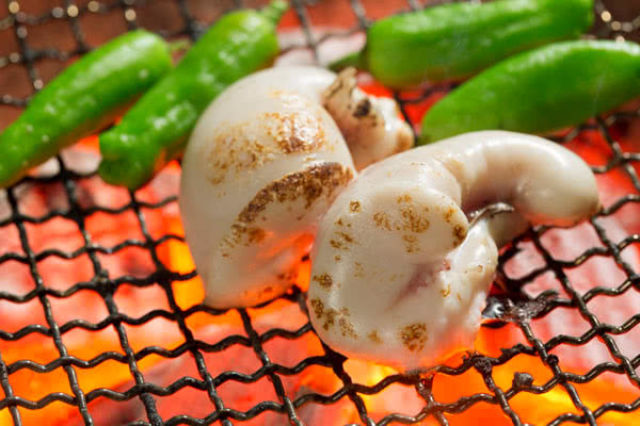
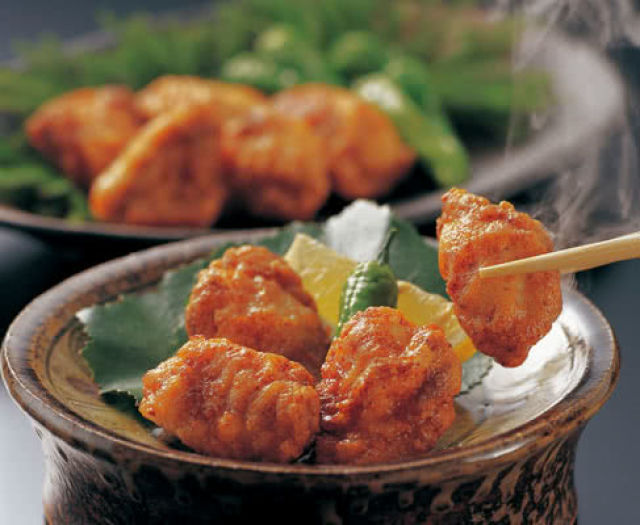
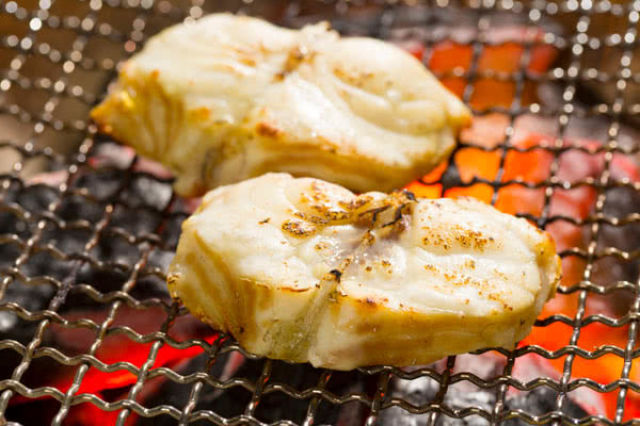 Sumi means charcoal in Japanese, and sumibiyaki is to grill something over a charcoal fire. Fugu grilled over a charcoal fire is imbued with the smoky flavor of the charcoal, while retaining a juiciness to the meat. It may be cooked as-is, or brushed with a teriyaki sauce of sweetened soy sauce. Fugu cooked in this way has a rich, barbecue-infused flavor.
Sumi means charcoal in Japanese, and sumibiyaki is to grill something over a charcoal fire. Fugu grilled over a charcoal fire is imbued with the smoky flavor of the charcoal, while retaining a juiciness to the meat. It may be cooked as-is, or brushed with a teriyaki sauce of sweetened soy sauce. Fugu cooked in this way has a rich, barbecue-infused flavor.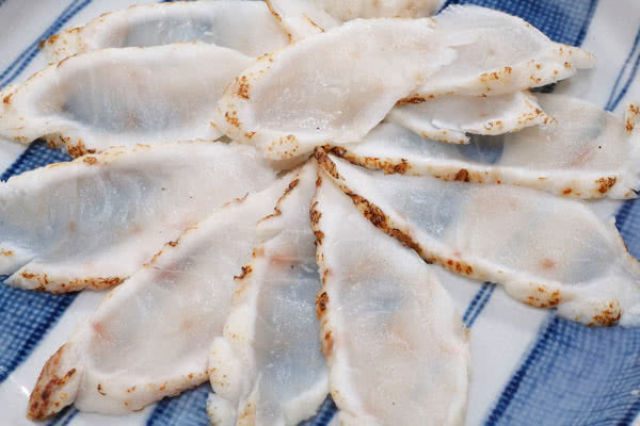 Tataki is a Japanese cooking technique where a piece of meat or fish is flash-grilled to sear the outside while keeping the inside raw. It’s then sliced into large chunky slices and served with various condiments. Fugu tataki is most commonly served with sudachi lime, myoga (Japanese ginger) and ponzu (citrus-seasoned soy sauce).
Tataki is a Japanese cooking technique where a piece of meat or fish is flash-grilled to sear the outside while keeping the inside raw. It’s then sliced into large chunky slices and served with various condiments. Fugu tataki is most commonly served with sudachi lime, myoga (Japanese ginger) and ponzu (citrus-seasoned soy sauce).